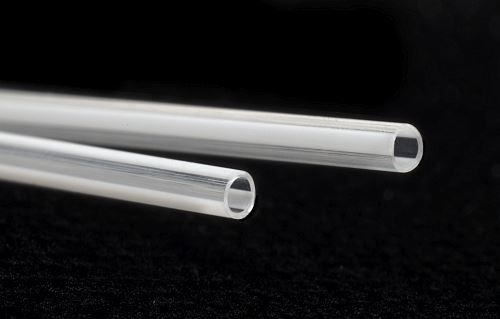Processing/Workplace Safety Tips for Fluoropolymer Medical Tubing
Here's what you need to know and running these emerging materials for medical tubing.
Materials such as FEP, PFA, PVDF and ETFE are known for their excellent physical properties and hold promise for many medical applications, such as micro tubing for intravenous (IV) catheters and insulin infusion, single lumen and multi-lumen tubing for endoscopy and cardiology devices, and heat shrink tubing used as a manufacturing aid for catheter reflow purposes. American Kuhne extrusion systems have been employed for such applications.
Here are some important considerations that we have identified regarding extrusion equipment and safety related to processing fluoropolymers:
Components that come in contact with molten resin such as the die head, tooling, adapter, breaker plate, and screw should be made of corrosion-resistant metals with high nickel content like Inconel 625 or Hastelloy C276. For corrosion protection of the extruder barrel, a tungsten carbide/nickel-based bimetallic barrel liner such as X800 is recommended. For small medical extruders, 1.25-inch (32 mm) and smaller, the entire backing material of the bimetallic barrel is solid Inconel and the liner material is X800.
The typical fluoropolymer screw is a single-flight design with a 3:1 compression ratio. In some cases a low-shear Saxton-type distributive mixer is included at the end of the screw. Although Inconel and Hastelloy are corrosion-resistant, these specialty metals have low torsional strength compared to common screws that are made of 4140 or 4340 heat-treated steel. For instance, Hastelloy 625 has a yield strength of approximately 52,000 psi (359 MPa), about half that of 4140 steel at 28-32 Rc. Inconel 625 is a little stronger than Hastelloy C276 but is not as corrosion resistant. Care must be taken to avoid screw breakage when using an Inconel or Hastelloy screw while processing other high temperature polymers that are not corrosive such as PEEK, polysulfone (PSU) and polyetherimide (PEI). For example, a 1-in. (25-mm) extruder with a 5HP motor geared for 100 rpm screw speed is very likely to snap a screw made from Hastelloy 625 during a cold start situation.
Fluoropolymers have high melting points. For instance, PFA has a melting point at about 305 C (581 F). The barrel set points for FEP are in the 600-740 F range; therefore the extruder barrel heaters should be made from cast bronze and rated up to 480 C (900 F). Due to the high operating temperatures, a special dual-layer barrel safety shroud should be used over the barrel to protect the operator from burns.
Fluoropolymers are also highly susceptible to melt fracture (“shark skin” appearance) on the surface of tubing, caused by excessive shear in the die tooling gaps as output rates are increased. The typical approach to avoiding melt fracture is to utilize larger tooling gaps, which means making the tubing with a larger drawdown. Tooling drawdowns of 3:1 to 20:1 are common for many polymers, whereas processors of fluoropolymers have used drawdowns of 50:1 or greater.
Proper safety measures are important to consider when processing fluoropolymers. According to the Guide to the Safe Handling of Fluoropolymer Resins, published by the Fluoropolymers Division of the Plastics Industry Association (formerly SPI), gases, vapors and fumes released during the extrusion of fluoropolymers may be harmful to human health.
Vapors and fumes released during extrusion and while cleaning the die head can cause flu-like symptoms (chills, headaches, fever) that typically pass within 24 to 48 hr. The corrosive gases should be captured immediately and removed with an exhaust ventilation system that includes extraction hoods, ducting, and a fan. Extraction hoods should be placed above the die head and, for large-diameter tubing, an additional extraction hood over the area where the tubing is cut to length. Sealed packages of fluoropolymer resins should only be opened in well ventilated areas. Consult the resin supplier’s MSDS for specific recommendations.
ABOUT THE AUTHOR
Steve Maxson is director of global business development-extrusion for Graham Engineering Corp, owner of American Kuhne Inc. He is responsible for sales, marketing, product development and M&A. Steve’s background combines disciplines from the fields of medical extrusion technology and medical device manufacturing. He holds a BS in Mechanical Engineering Technology from Wentworth Institute of Technology and a MBA from Rensselaer Polytechnic Institute. Contact: smaxson@grahamengineering.com.
Related Content
Solve Four Common Problems in PET Stretch-Blow Molding
Here’s a quick guide to fixing four nettlesome problems in processing PET bottles.
Read MorePregis Performance Flexibles: In the ‘Wow’ Business
Pregis went big and bold with investment in a brand-new, state-of-the-art plant and spent big on expanding an existing facility. High-tech lines, well-known leadership and a commitment to sustainability are bringing the “wow” factor to blown film.
Read More‘Monomaterial’ Trend in Packaging and Beyond Will Only Thrive
In terms of sustainability measures, monomaterial structures are already making good headway and will evolve even further.
Read MoreFoam-Core Multilayer Blow Molding: How It’s Done
Learn here how to take advantage of new lightweighting and recycle utilization opportunities in consumer packaging, thanks to a collaboration of leaders in microcellular foaming and multilayer head design.
Read MoreRead Next
Troubleshooting Screw and Barrel Wear in Extrusion
Extruder screws and barrels will wear over time. If you are seeing a reduction in specific rate and higher discharge temperatures, wear is the likely culprit.
Read MorePeople 4.0 – How to Get Buy-In from Your Staff for Industry 4.0 Systems
Implementing a production monitoring system as the foundation of a ‘smart factory’ is about integrating people with new technology as much as it is about integrating machines and computers. Here are tips from a company that has gone through the process.
Read MoreHow Polymer Melts in Single-Screw Extruders
Understanding how polymer melts in a single-screw extruder could help you optimize your screw design to eliminate defect-causing solid polymer fragments.
Read More



























